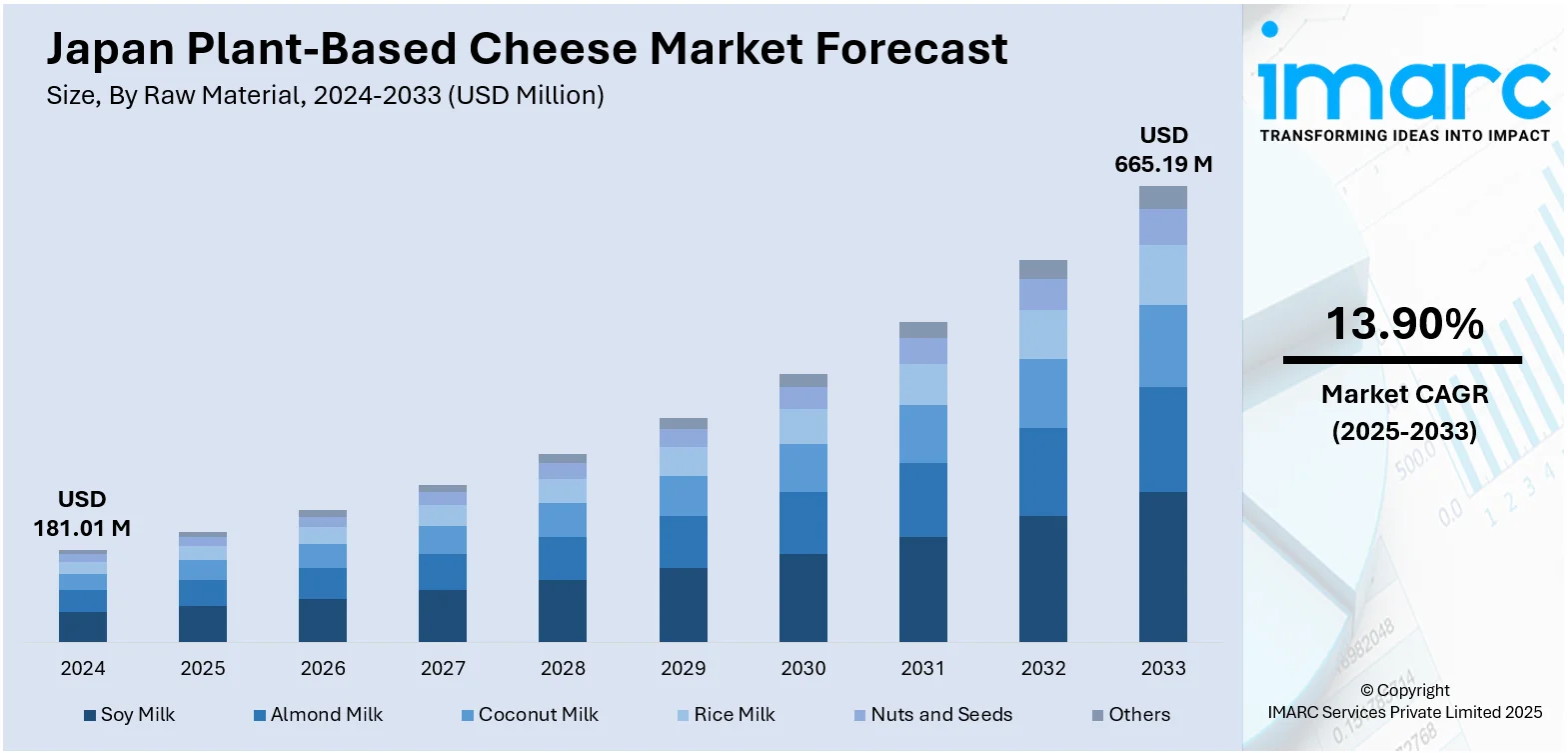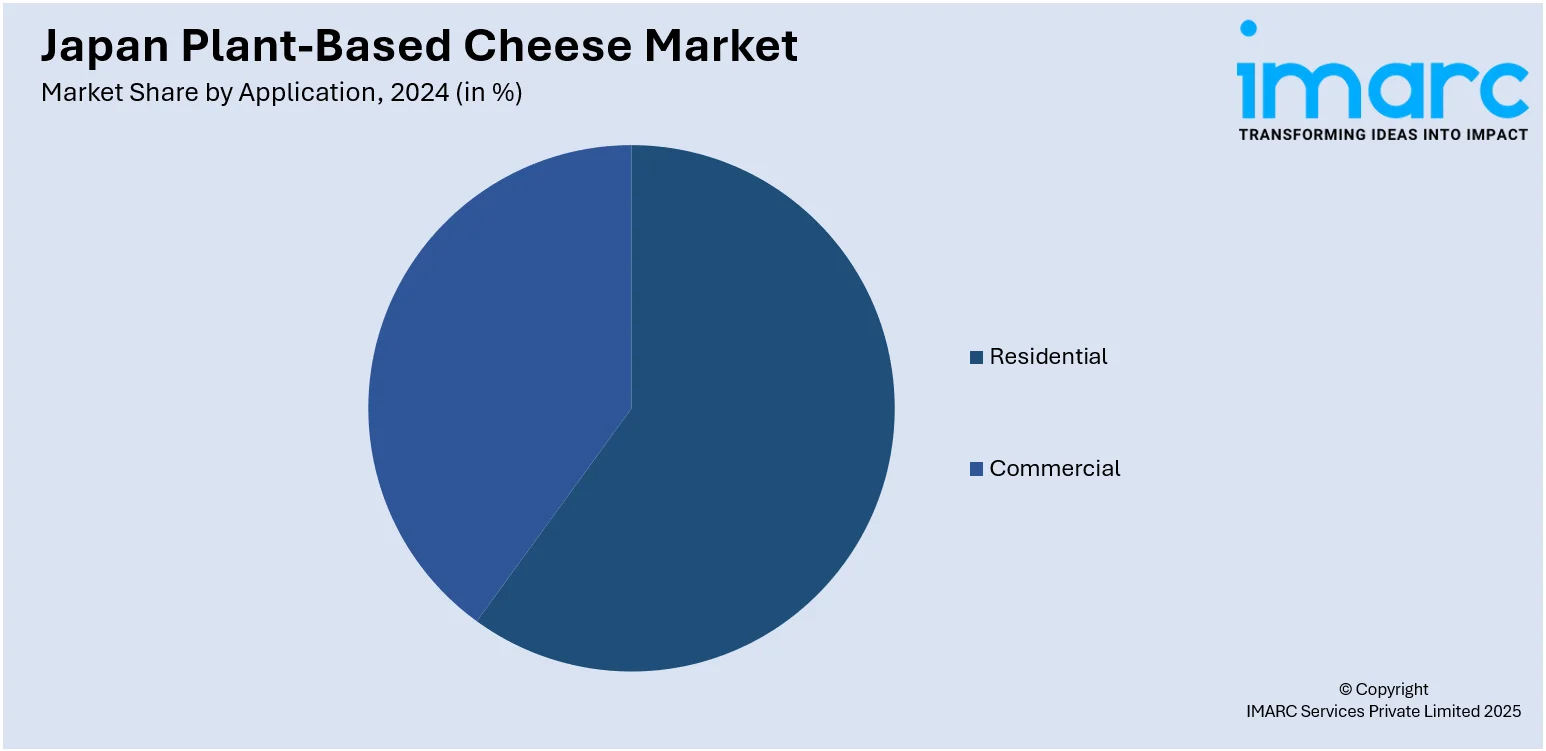
Japan Plant-Based Cheese Market Size, Share, Trends and Forecast by Raw Material, Product Type, Application, Distribution Channel, and Region, 2025-2033
Japan Plant-Based Cheese Market Overview:
The Japan plant-based cheese market size reached USD 181.01 Million in 2024. Looking forward, IMARC Group expects the market to reach USD 665.19 Million by 2033, exhibiting a growth rate (CAGR) of 13.90% during 2025-2033. At present, with an increasing number of individuals adopting vegan lifestyles for health, ethical, and environmental reasons, they are looking for products that reflect their beliefs. This is driving the demand for plant-based cheese in the country. Besides this, the broadening of e-commerce portals is contributing to the expansion of the Japan plant-based cheese market share.
|
Report Attribute
|
Key Statistics
|
|---|---|
|
Base Year
|
2024 |
|
Forecast Years
|
2025-2033
|
|
Historical Years
|
2019-2024
|
| Market Size in 2024 | USD 181.01 Million |
| Market Forecast in 2033 | USD 665.19 Million |
| Market Growth Rate 2025-2033 | 13.90% |
Japan Plant-Based Cheese Market Trends:
Growing adoption of veganism
Rising adoption of veganism is positively influencing the market in Japan. As more people in the country are choosing vegan lifestyles for health, ethical, and environmental reasons, they continue to seek food products that align with their values. According to the IMARC Group, the Japan vegan food market size was valued at USD 1.2 Billion in 2024. Plant-based cheese offers a cruelty-free and lactose-free option that fits well into vegan diets. The growing vegan population is encouraging food manufacturers to expand their offerings of plant-based cheese. Restaurants and cafes are also responding by including plant-based cheese in their menus, catering to vegan and flexitarian consumers. The influence of social media and increased awareness about animal welfare is further supporting this trend, motivating people to shift from traditional dairy cheese to plant-based options. Additionally, Japanese consumers appreciate innovative flavors and high-quality products, motivating companies to improve taste and texture in plant-based cheese. This rising interest is not only increasing sales but also promoting product development and diversification in the market. Overall, the growth of veganism plays an important role in driving the expansion and adoption of plant-based cheese in Japan.

To get more information on this market, Request Sample
Expansion of e-commerce portals
The broadening of e-commerce sites is impelling the Japan plant-based cheese market growth. As per industry reports, the e-commerce market in Japan produced a revenue of USD 109,971 Million in 2024, indicating an expansion rate of 5-10% in relation to 2023. Online platforms allow customers to easily browse, compare, and purchase a wide variety of plant-based cheese options from the comfort of their homes. This ease attracts busy individuals who prefer shopping online rather than visiting physical stores. E-commerce also enables small and new brands to enter the market and reach a wider audience without the high costs of traditional retail distribution. Subscription services and direct-to-consumer (D2C) sales through websites and apps increase customer loyalty and repeat purchases. Moreover, online reviews and social media integration help people make better decisions and discover new products. As e-commerce platforms are growing, more individuals are opting for online shopping to buy groceries and specialty food items. Overall, the broadening of e-commerce platforms is supporting the expansion of the plant-based cheese market in Japan by improving product availability, boosting brand visibility, and enhancing customer convenience.
Japan Plant-Based Cheese Market Segmentation:
IMARC Group provides an analysis of the key trends in each segment of the market, along with forecasts at the country and regional levels for 2025-2033. Our report has categorized the market based on raw material, product type, application, and distribution channel.
Raw Material Insights:
- Soy Milk
- Almond Milk
- Coconut Milk
- Rice Milk
- Nuts and Seeds
- Others
The report has provided a detailed breakup and analysis of the market based on the raw material. This includes soy milk, almond milk, coconut milk, rice milk, nuts and seeds, and others.
Product Type Insights:
- Mozzarella
- Parmesan
- Cheddar
- Others
A detailed breakup and analysis of the market based on the product type have also been provided in the report. This includes mozzarella, parmesan, cheddar, and others.
Application Insights:

- Residential
- Commercial
The report has provided a detailed breakup and analysis of the market based on the application. This includes residential and commercial.
Distribution Channel Insights:
- Offline Stores
- Online Stores
A detailed breakup and analysis of the market based on the distribution channel have also been provided in the report. This includes offline stores and online stores.
Regional Insights:
- Kanto Region
- Kansai/Kinki Region
- Central/ Chubu Region
- Kyushu-Okinawa Region
- Tohoku Region
- Chugoku Region
- Hokkaido Region
- Shikoku Region
The report has also provided a comprehensive analysis of all the major regional markets, which include Kanto Region, Kansai/Kinki Region, Central/ Chubu Region, Kyushu-Okinawa Region, Tohoku Region, Chugoku Region, Hokkaido Region, and Shikoku Region.
Competitive Landscape:
The market research report has also provided a comprehensive analysis of the competitive landscape. Competitive analysis such as market structure, key player positioning, top winning strategies, competitive dashboard, and company evaluation quadrant has been covered in the report. Also, detailed profiles of all major companies have been provided.
Japan Plant-Based Cheese Market News:
- In August 2024, Fujiya, a restaurant chain from Japan in the Tokushima and Kagawa regions, introduced a plant-based meat product line named Nikugoe, created from sorghum (takakibi) sourced from Tokushima. The offerings featured Meat Super Cheese Hamburger, Meat Super Gyoza, and Demi Sauce Meat Super Cheese Hamburger. These items were vegan-labelled by the NPO Vege Project Japan.
Japan Plant-Based Cheese Market Report Coverage:
| Report Features | Details |
|---|---|
| Base Year of the Analysis | 2024 |
| Historical Period | 2019-2024 |
| Forecast Period | 2025-2033 |
| Units | Million USD |
| Scope of the Report |
Exploration of Historical Trends and Market Outlook, Industry Catalysts and Challenges, Segment-Wise Historical and Future Market Assessment:
|
| Raw Materials Covered | Soy Milk, Almond Milk, Coconut milk, Rice Milk, Nuts and Seeds, Others |
| Product Types Covered | Mozzarella, Parmesan, Cheddar, Others |
| Applications Covered | Residential, Commercial |
| Distribution Channels Covered | Offline Stores, Online Stores |
| Regions Covered | Kanto Region, Kansai/Kinki Region, Central/ Chubu Region, Kyushu-Okinawa Region, Tohoku Region, Chugoku Region, Hokkaido Region, Shikoku Region |
| Customization Scope | 10% Free Customization |
| Post-Sale Analyst Support | 10-12 Weeks |
| Delivery Format | PDF and Excel through Email (We can also provide the editable version of the report in PPT/Word format on special request) |
Key Questions Answered in This Report:
- How has the Japan plant-based cheese market performed so far and how will it perform in the coming years?
- What is the breakup of the Japan plant-based cheese market on the basis of raw material?
- What is the breakup of the Japan plant-based cheese market on the basis of product type?
- What is the breakup of the Japan plant-based cheese market on the basis of application?
- What is the breakup of the Japan plant-based cheese market on the basis of distribution channel?
- What is the breakup of the Japan plant-based cheese market on the basis of region?
- What are the various stages in the value chain of the Japan plant-based cheese market?
- What are the key driving factors and challenges in the Japan plant-based cheese market?
- What is the structure of the Japan plant-based cheese market and who are the key players?
- What is the degree of competition in the Japan plant-based cheese market?
Key Benefits for Stakeholders:
- IMARC’s industry report offers a comprehensive quantitative analysis of various market segments, historical and current market trends, market forecasts, and dynamics of the Japan plant-based cheese market from 2019-2033.
- The research report provides the latest information on the market drivers, challenges, and opportunities in the Japan plant-based cheese market.
- Porter's five forces analysis assist stakeholders in assessing the impact of new entrants, competitive rivalry, supplier power, buyer power, and the threat of substitution. It helps stakeholders to analyze the level of competition within the Japan plant-based cheese industry and its attractiveness.
- Competitive landscape allows stakeholders to understand their competitive environment and provides an insight into the current positions of key players in the market.
Need more help?
- Speak to our experienced analysts for insights on the current market scenarios.
- Include additional segments and countries to customize the report as per your requirement.
- Gain an unparalleled competitive advantage in your domain by understanding how to utilize the report and positively impacting your operations and revenue.
- For further assistance, please connect with our analysts.
 Request Customization
Request Customization
 Speak to an Analyst
Speak to an Analyst
 Request Brochure
Request Brochure
 Inquire Before Buying
Inquire Before Buying




.webp)




.webp)












